Hmm, what a funky word. Shmups. Not a lot of people like the term (short for shoot-’em-ups) but I tend to prefer it as “shooter” now seems to be used more for FPS games these days. I don’t pretend to be “hardcore” or any such nonsense; I just like the way it sounds. Shmups… kind of rolls off the tongue.
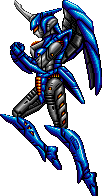 More than any other single word, I think it pretty much sums up perhaps the Genesis’ strongest genre. Cut through the waves of platformers, excellent sports titles, incredible action games, and you’ll find them. Tens of titles – vertical, horizontal, and beyond – all sharing a common theme: save the universe! Some do it better than others and some downright suck. You cannot, however, deny that the early ’90s was a shmupper’s paradise on the system and no other console of the time (save perhaps the PC-Engine) came close to matching the incredible library the Genesis was home to.
More than any other single word, I think it pretty much sums up perhaps the Genesis’ strongest genre. Cut through the waves of platformers, excellent sports titles, incredible action games, and you’ll find them. Tens of titles – vertical, horizontal, and beyond – all sharing a common theme: save the universe! Some do it better than others and some downright suck. You cannot, however, deny that the early ’90s was a shmupper’s paradise on the system and no other console of the time (save perhaps the PC-Engine) came close to matching the incredible library the Genesis was home to.
Far too many of the better ones were left behind in Japan (Eliminate Down, Panorama Cotton, Gleylancer) but most of them were localized, for better or for worse. Though there are over eighty games in the genre on the Genesis, a few rise above the rest of the pack and really show off what Sega’s 16-bit wonder could do. This makes it difficult to find a true “best shmup” among the lineup. I do think, however, that there are quite a few deserving of mention. With this article, Sega-16 hopes to provide a “definitive list,” or buyers guide, for every shmup available on the Genesis, Sega CD, and 32X, both domestic and import.
I would like to thank the now-defunct Starbase299 for some of the sprites. Once one of the best sites on the internet for information on shmups, it is now sadly gone. Sega-16 intends to honor and preserve what Ghostwalker created and will acknowledge all content used from his former site.
Now, on to the games!
Horizontal Shmups
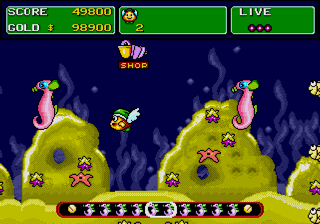 Chinese game developer Gametec was quite able at taking a formula and… how can I put this delicately… “emulating” it. Such is the case with Adventurous Boy, an unlicensed shooter that takes more than a casual inspiration from Sega’s classic Fantasy Zone franchise. Whether such work should be considered homage or straight up plagiarism is for the fans to decide, but in the end, Adventurous Boy is not actually all that exciting. Everything, and I do mean EVERYTHING is taken from Fantasy Zone, which is a pretty solid formula, so if you’re a fan of that series then you perhaps think that you’ll enjoy Gamtec’s version. That first impression is deceptive though. Sure, detailed and colorful visuals and “pick up and play” gameplay always go together like peanut butter and chocolate, so think of Adventurous Boy as the generic store brand to Sega’s Reece’s, right? Not quite. Countering the decent visuals is a soundtrack that’s grating, and some of the weapons are just ridiculously overpowered. The game is still playable, providing that you don’t die. Losing a life means losing all your power-ups and starting with some Gradius level pea shooter and speed. You can go from being the King of Space to watching a “game over” screen really fast after losing that first life.
Chinese game developer Gametec was quite able at taking a formula and… how can I put this delicately… “emulating” it. Such is the case with Adventurous Boy, an unlicensed shooter that takes more than a casual inspiration from Sega’s classic Fantasy Zone franchise. Whether such work should be considered homage or straight up plagiarism is for the fans to decide, but in the end, Adventurous Boy is not actually all that exciting. Everything, and I do mean EVERYTHING is taken from Fantasy Zone, which is a pretty solid formula, so if you’re a fan of that series then you perhaps think that you’ll enjoy Gamtec’s version. That first impression is deceptive though. Sure, detailed and colorful visuals and “pick up and play” gameplay always go together like peanut butter and chocolate, so think of Adventurous Boy as the generic store brand to Sega’s Reece’s, right? Not quite. Countering the decent visuals is a soundtrack that’s grating, and some of the weapons are just ridiculously overpowered. The game is still playable, providing that you don’t die. Losing a life means losing all your power-ups and starting with some Gradius level pea shooter and speed. You can go from being the King of Space to watching a “game over” screen really fast after losing that first life.
I don’t know if many gamers will find it worth the time to track down, as it’s kind of hard to find, and prices can get pretty high. Overall, perhaps what Adventurous Boy has most going for it is the fact that it’s a rare shmup and it’s not a bootleg. Hmm, maybe it would be better to just stick with Reece’s after all…
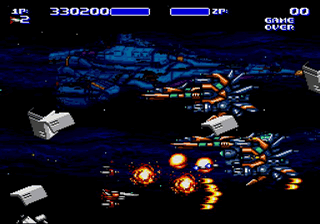 The first thing that comes to mind when I think of Air Buster is the special offer Kaneko had for it. If you bought the game, you could send off for an exclusive glove for your right hand! Tasteless jokes aside, Kaneko thought highly enough of their effort that they felt the blistering gameplay required protection for the player! I could not see myself wearing that glove, but I do have to agree that Air Buster is a great game. Huge, colorful stages and two-player cooperative mode bring a lot to the table, and the bosses are incredible. Perhaps my favorite part is having to fly through some narrow tunnels, Star Wars-style. Also released on the PC-Engine as Air Blasters, I’m unsure as to what the differences are between it and the Genesis and arcade versions. It’s hard to believe that this was one of the early third-party efforts on the Genesis (and by Kaneko, no less). The developer should have stayed away from fighting games and concentrated on shmups.
The first thing that comes to mind when I think of Air Buster is the special offer Kaneko had for it. If you bought the game, you could send off for an exclusive glove for your right hand! Tasteless jokes aside, Kaneko thought highly enough of their effort that they felt the blistering gameplay required protection for the player! I could not see myself wearing that glove, but I do have to agree that Air Buster is a great game. Huge, colorful stages and two-player cooperative mode bring a lot to the table, and the bosses are incredible. Perhaps my favorite part is having to fly through some narrow tunnels, Star Wars-style. Also released on the PC-Engine as Air Blasters, I’m unsure as to what the differences are between it and the Genesis and arcade versions. It’s hard to believe that this was one of the early third-party efforts on the Genesis (and by Kaneko, no less). The developer should have stayed away from fighting games and concentrated on shmups.
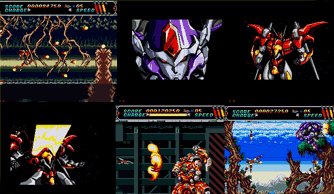 One of my favorite shmups on the Sega CD, Bari-Arm, or Android Assault as it’s called in the U.S., is a fine, fine game. The huge, multi-screen levels and crisp graphics look at home on Sega’s oft-neglected add-on, and the music is incredible. Throw in some huge bosses and the ability to transform your ship into a mech and you’ve got one of the more underrated shmups. It’s sad that this game can be had almost anywhere for peanuts and far too few people are even aware that it exists. Being a Sega CD fan myself, I can wholeheartedly recommend Android Assault for those who love blasting enemies in all sorts of environments (the waterfall level is gorgeous) as well as anyone looking for another title for their collection. It’s a great little game that is very easy to get into and is neither too short nor too long. Though the power ups are quite generic, the action is quick and smooth. If you’re looking for a great shmup for your Sega CD, look no further.
One of my favorite shmups on the Sega CD, Bari-Arm, or Android Assault as it’s called in the U.S., is a fine, fine game. The huge, multi-screen levels and crisp graphics look at home on Sega’s oft-neglected add-on, and the music is incredible. Throw in some huge bosses and the ability to transform your ship into a mech and you’ve got one of the more underrated shmups. It’s sad that this game can be had almost anywhere for peanuts and far too few people are even aware that it exists. Being a Sega CD fan myself, I can wholeheartedly recommend Android Assault for those who love blasting enemies in all sorts of environments (the waterfall level is gorgeous) as well as anyone looking for another title for their collection. It’s a great little game that is very easy to get into and is neither too short nor too long. Though the power ups are quite generic, the action is quick and smooth. If you’re looking for a great shmup for your Sega CD, look no further.
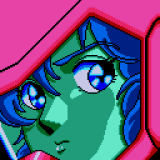 Renovation was very good to Genesis shmup fans, offering lots of games in the genre. Gaiares, Whip Rush, Vapor Trail, and Granada were some great games that are still a blast to play. Among this group was a little-known shmup called Arrow Flash. It came out very quietly in 1990 and was soon overshadowed by Gaiares and Thunder Force III. While not very original or innovative, Arrow Flash still has some merit and is worth tracking down. Decent graphics and great parallax, combined with some solid gameplay make for a decent time. They could have done more with the whole transformation feature (your ship can become a tiny mech) and the weapons were slightly underwhelming, but overall, the game is a decent play.
Renovation was very good to Genesis shmup fans, offering lots of games in the genre. Gaiares, Whip Rush, Vapor Trail, and Granada were some great games that are still a blast to play. Among this group was a little-known shmup called Arrow Flash. It came out very quietly in 1990 and was soon overshadowed by Gaiares and Thunder Force III. While not very original or innovative, Arrow Flash still has some merit and is worth tracking down. Decent graphics and great parallax, combined with some solid gameplay make for a decent time. They could have done more with the whole transformation feature (your ship can become a tiny mech) and the weapons were slightly underwhelming, but overall, the game is a decent play.
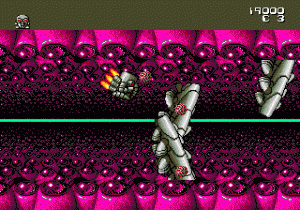 Perhaps one of the strangest shmups on any system, Atomic Robo-Kid appeared on the scene back in 1990 and was hardly even noticed. The now-defunct developer Treco introduced American audiences to the pudgy little hero, who looked more like a trash can with a hose glued to it than the savior of mankind. Not the most energetic of shmups, it can tend to get tedious after some time, since most of the levels look the same and there isn’t really anything going on to get you excited. The soundtrack is just as repetitive, and while the game isn’t bad, it’s not exceptionally good either. There are some interesting boss battles (the last guy is a bastard!), and the graphics are decent enough. The gameplay, however, is very middle-of-the-road and the levels are uninspired. Atomic Robo-Kid is an early effort by one of the first Genesis licensees, and it shows. Pick it up if you can find it cheap, or spring for the PC-Engine or C64 versions instead.
Perhaps one of the strangest shmups on any system, Atomic Robo-Kid appeared on the scene back in 1990 and was hardly even noticed. The now-defunct developer Treco introduced American audiences to the pudgy little hero, who looked more like a trash can with a hose glued to it than the savior of mankind. Not the most energetic of shmups, it can tend to get tedious after some time, since most of the levels look the same and there isn’t really anything going on to get you excited. The soundtrack is just as repetitive, and while the game isn’t bad, it’s not exceptionally good either. There are some interesting boss battles (the last guy is a bastard!), and the graphics are decent enough. The gameplay, however, is very middle-of-the-road and the levels are uninspired. Atomic Robo-Kid is an early effort by one of the first Genesis licensees, and it shows. Pick it up if you can find it cheap, or spring for the PC-Engine or C64 versions instead.
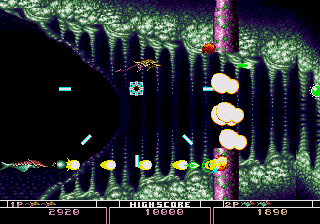 If you thought Insector X was the pinnacle of mutant bug shmupping, you were wrong. Bio-Hazard Battle takes things up a notch and is a solid outing that largely went unnoticed on the Genesis. That’s a shame, as the crisp, clear graphics and tight gameplay are more than worthy of your time. Some of the mutant creations you’ll face are downright weird-looking but I guess that’s what makes them mutants, right?
If you thought Insector X was the pinnacle of mutant bug shmupping, you were wrong. Bio-Hazard Battle takes things up a notch and is a solid outing that largely went unnoticed on the Genesis. That’s a shame, as the crisp, clear graphics and tight gameplay are more than worthy of your time. Some of the mutant creations you’ll face are downright weird-looking but I guess that’s what makes them mutants, right?
You can choose from four “ships,” each with a unique weapon. Options can be attained to assist you with a great eight-way missile attack or homing lasers. Regardless of which one you choose, the games remain more or less the same in terms of difficulty.
A semi-obscure title that can be had for beans, Bio-Hazard Battle comes highly recommended.
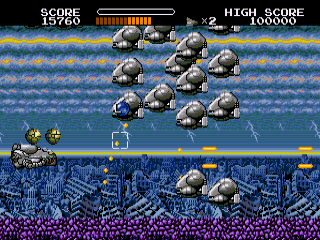 Every so often a shmup tries to break away from the standard game dynamics of its predecessors and be innovative. Bio-ship Paladin is one such game. As the name implies, your ship takes on new forms whenever you snatch a power up, and sort of evolves, much like Darwin 4081. The only problem with this is that it doesn’t translate to the gameplay as well as it should. You fire with the A button and use the B button to move around a cursor for a powerful attack. Your ship, being the slug that it is, cannot move when you use this weapon, essentially leaving making you a sitting duck. Switching between both armaments would be no problem were your ship’s default speed faster than a one-legged man without a cane. Almost as if the developers knew this, they implemented a life bar, and you’ll need it as you scramble around the screen trying to switch back and forth between the two guns. Good graphics and sound don’t go far enough to make up for this gameplay fumble. I guess the gameplay just didn’t evolve enough. The two-player simultaneous option is nice, but I can imagine the potential confusion as both players scramble to change weapons.
Every so often a shmup tries to break away from the standard game dynamics of its predecessors and be innovative. Bio-ship Paladin is one such game. As the name implies, your ship takes on new forms whenever you snatch a power up, and sort of evolves, much like Darwin 4081. The only problem with this is that it doesn’t translate to the gameplay as well as it should. You fire with the A button and use the B button to move around a cursor for a powerful attack. Your ship, being the slug that it is, cannot move when you use this weapon, essentially leaving making you a sitting duck. Switching between both armaments would be no problem were your ship’s default speed faster than a one-legged man without a cane. Almost as if the developers knew this, they implemented a life bar, and you’ll need it as you scramble around the screen trying to switch back and forth between the two guns. Good graphics and sound don’t go far enough to make up for this gameplay fumble. I guess the gameplay just didn’t evolve enough. The two-player simultaneous option is nice, but I can imagine the potential confusion as both players scramble to change weapons.
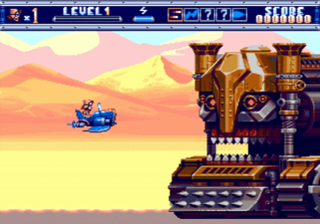 Neofid Studios, the group behind Demons of Asteborg and Astebros, decided to switch genres and release a steampunk-themed shmup that took inspiration of Thunder Force IV and SNK’s Metal Slug. It has stages that are several screens tall, as well as areas where the main character, Jim, exits his plane and fights on foot. Copper Storm crushed its Kickstarter goal and achieved all stretch goals, and it brings solid shooter action to the Genesis using a theme not really seen outside of Steel Empire. Neofid has been solid on the Genesis thus far, and Copper Storm is one title you’re going to want in your library.
Neofid Studios, the group behind Demons of Asteborg and Astebros, decided to switch genres and release a steampunk-themed shmup that took inspiration of Thunder Force IV and SNK’s Metal Slug. It has stages that are several screens tall, as well as areas where the main character, Jim, exits his plane and fights on foot. Copper Storm crushed its Kickstarter goal and achieved all stretch goals, and it brings solid shooter action to the Genesis using a theme not really seen outside of Steel Empire. Neofid has been solid on the Genesis thus far, and Copper Storm is one title you’re going to want in your library.
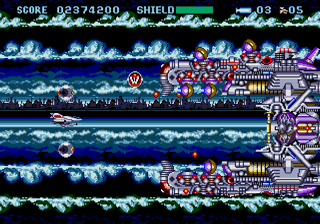 Curse has probably the most apt name of any video game I’ve ever played. It was slated for a U.S. release by INTV Corp. in 1990, but never arrived. It was instead left in Japan, where it quickly slid out of the public eye and into obscurity. Add to this the fact that other, more successful shmups like the almighty Thunder Force III were snapping up gamer’s shmupping dollars, and it’s no wonder that the game disappeared. Its worst enemy, however, has to be just how utterly average it is. Honestly, I’ve yet to play a Micronet game that didn’t make me yawn. Presentation is bare bones, and the gameplay is very cookie cutter. Subpar animation (what’s with the choppy scrolling?) and the dreaded “snail speed” your ship starts out with will make you reach for the power button. Not a bad shmup, but there’s just so much better on this list for you to spend your cash on.
Curse has probably the most apt name of any video game I’ve ever played. It was slated for a U.S. release by INTV Corp. in 1990, but never arrived. It was instead left in Japan, where it quickly slid out of the public eye and into obscurity. Add to this the fact that other, more successful shmups like the almighty Thunder Force III were snapping up gamer’s shmupping dollars, and it’s no wonder that the game disappeared. Its worst enemy, however, has to be just how utterly average it is. Honestly, I’ve yet to play a Micronet game that didn’t make me yawn. Presentation is bare bones, and the gameplay is very cookie cutter. Subpar animation (what’s with the choppy scrolling?) and the dreaded “snail speed” your ship starts out with will make you reach for the power button. Not a bad shmup, but there’s just so much better on this list for you to spend your cash on.
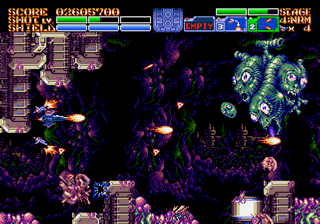 Decades after his last game, Genesis legend Yuzo Koshiro returned to the console to bring us an incredible shmup that rivals anything Technosoft has released (and that’s saying a lot!). The game’s eight stages are bursting with color and parallax, and the whole product shows that Koshiro still has something to prove with Sega’s 16-bit hardware. While also available for the PlayStation 4 & 5, Nintendo Switch, and Xbox X, we all know there’s only one version you need to get. Earthion comes packed in an old school cartridge and has a clamshell case and manual, and you know you want this one on your shelf.
Decades after his last game, Genesis legend Yuzo Koshiro returned to the console to bring us an incredible shmup that rivals anything Technosoft has released (and that’s saying a lot!). The game’s eight stages are bursting with color and parallax, and the whole product shows that Koshiro still has something to prove with Sega’s 16-bit hardware. While also available for the PlayStation 4 & 5, Nintendo Switch, and Xbox X, we all know there’s only one version you need to get. Earthion comes packed in an old school cartridge and has a clamshell case and manual, and you know you want this one on your shelf.
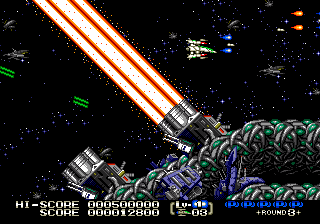 Another quality game that was never localized, Eliminate Down can honestly be ranked among the best 16-bit shmups of all time. One of what I like to call the “Forgotten Five” (along with Battlemania 2, Gleylancer, Panorama Cotton, and Undead Line), it truly sits at the top of the mountain. With a play style similar to R-Type and featuring some spectacular parallax scrolling, I’m amazed someone didn’t pick this up during the heyday of Genesis shmups. The graphics are great and the music rocks like a shmup soundtrack should. Moreover, the weapons system is highly intuitive and allows you to adjust on the fly, giving the impression that the game is easy, which it is not. The whole package is digital candy. Its rarity has made it one of the more expensive Mega Drive games out there but if you’re lucky enough to score a copy, get it! If there’s a downside, it’s the overall lack of a story. However, when did this ever really pose a problem in this genre? Shmups are about twitch gameplay and blowing stuff up and that is something that Eliminate Down has in spades.
Another quality game that was never localized, Eliminate Down can honestly be ranked among the best 16-bit shmups of all time. One of what I like to call the “Forgotten Five” (along with Battlemania 2, Gleylancer, Panorama Cotton, and Undead Line), it truly sits at the top of the mountain. With a play style similar to R-Type and featuring some spectacular parallax scrolling, I’m amazed someone didn’t pick this up during the heyday of Genesis shmups. The graphics are great and the music rocks like a shmup soundtrack should. Moreover, the weapons system is highly intuitive and allows you to adjust on the fly, giving the impression that the game is easy, which it is not. The whole package is digital candy. Its rarity has made it one of the more expensive Mega Drive games out there but if you’re lucky enough to score a copy, get it! If there’s a downside, it’s the overall lack of a story. However, when did this ever really pose a problem in this genre? Shmups are about twitch gameplay and blowing stuff up and that is something that Eliminate Down has in spades.
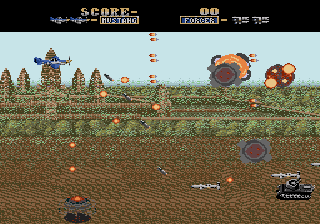 If you’re a fan of the 1941 games, then this is the shmup for you. It’s got all the fun and action of Capcom’s classic series, only from a horizontal perspective. It’s nice to see a Taito shmup here that isn’t part of the Darius series, and since WWII games are not a big part of the genre overall, Fire Mustang helps fit that particular niche. It’s a competent game in its own right and does a good job of conveying the feel of what the 1941 series might be like using this perspective, were that to ever happen. Funny how Capcom never tried that, given their experimentation with many of their franchises (Mega Man, Street Fighter, Ghosts ‘N Goblins). The only problem with Fire Mustang is that it’s only competent. Nothing really stands out, and while the action is enough to keep you interested, it won’t keep you coming back after the first play through. Decent graphics are overshadowed by a generic power up system, and even the boss battles are mediocre. Not a bad game by any means, but certainly not the best.
If you’re a fan of the 1941 games, then this is the shmup for you. It’s got all the fun and action of Capcom’s classic series, only from a horizontal perspective. It’s nice to see a Taito shmup here that isn’t part of the Darius series, and since WWII games are not a big part of the genre overall, Fire Mustang helps fit that particular niche. It’s a competent game in its own right and does a good job of conveying the feel of what the 1941 series might be like using this perspective, were that to ever happen. Funny how Capcom never tried that, given their experimentation with many of their franchises (Mega Man, Street Fighter, Ghosts ‘N Goblins). The only problem with Fire Mustang is that it’s only competent. Nothing really stands out, and while the action is enough to keep you interested, it won’t keep you coming back after the first play through. Decent graphics are overshadowed by a generic power up system, and even the boss battles are mediocre. Not a bad game by any means, but certainly not the best.
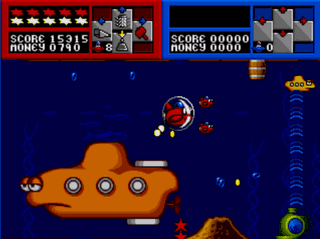 Imagine my surprise when I discovered that this game was actually a shmup. I had long believed it to be an infantile platformer and dismissed it without ever giving it a chance (big boo-boo, I know). Some time ago, I decided to finally try it out, and while it’s nowhere’s near classics like Thunder Force and M.U.S.H.A., it’s not as bad as you might think by looking at this screen shot. The graphics, all colorful and bright, are very cartoony and detailed, and parallax abounds. I did find the main attack to be quite awkward, as your ship launches a little spring boxing glove with which it smacks oncoming foes and opens treasure chests for goodies. One button changes its direction and the other actually attacks, and this can be a problem when more than a few enemies assault you at once. Aside from this, Gadget Twins is probably worth picking up and giving a few walkthroughs. It’s not the hottest thing around, but it’s far from the worst.
Imagine my surprise when I discovered that this game was actually a shmup. I had long believed it to be an infantile platformer and dismissed it without ever giving it a chance (big boo-boo, I know). Some time ago, I decided to finally try it out, and while it’s nowhere’s near classics like Thunder Force and M.U.S.H.A., it’s not as bad as you might think by looking at this screen shot. The graphics, all colorful and bright, are very cartoony and detailed, and parallax abounds. I did find the main attack to be quite awkward, as your ship launches a little spring boxing glove with which it smacks oncoming foes and opens treasure chests for goodies. One button changes its direction and the other actually attacks, and this can be a problem when more than a few enemies assault you at once. Aside from this, Gadget Twins is probably worth picking up and giving a few walkthroughs. It’s not the hottest thing around, but it’s far from the worst.
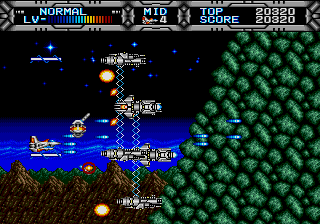 Here’s a title that attracts controversy. A classic to some, an overrated, mediocre effort to others, Gaiares is a game that commands attention. Brought over by Telenet (Renovation in the U.S.), it caught on with many gamers and quickly garnered a following. Big bosses and an innovative power up system (you latched your TOZ system onto enemies to steal their weapons) came wrapped in some great graphics and an excellent soundtrack. There was also a deep plot (well, deep for a shmup anyway) that was developed through some great-looking cut scenes (remember Valis III?). The game received many accolades from most of the gaming publications of the time, especially GamePro, and even won a few awards. I really enjoyed it, although the difficulty level was a bit off-putting at the beginning. The game is solid and highly replayable and should definitely be in your library.
Here’s a title that attracts controversy. A classic to some, an overrated, mediocre effort to others, Gaiares is a game that commands attention. Brought over by Telenet (Renovation in the U.S.), it caught on with many gamers and quickly garnered a following. Big bosses and an innovative power up system (you latched your TOZ system onto enemies to steal their weapons) came wrapped in some great graphics and an excellent soundtrack. There was also a deep plot (well, deep for a shmup anyway) that was developed through some great-looking cut scenes (remember Valis III?). The game received many accolades from most of the gaming publications of the time, especially GamePro, and even won a few awards. I really enjoyed it, although the difficulty level was a bit off-putting at the beginning. The game is solid and highly replayable and should definitely be in your library.
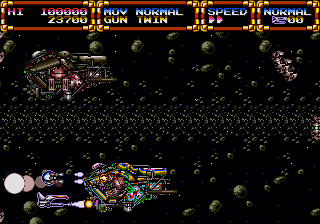 Most famous for its Engrish title translation, Gleylancer is perhaps one of the best 16-bit shmups ever made. As the pilot of an experimental fighter craft, you can end the war that rages between two massive star fleets. You might also find out what happened to your missing father in the process. Gleylancer is the second of the “Forgotten Five” I mentioned earlier here, and it is definitely worth your import dollar. Tons of parallax, an actual plot, and tons of terrific action are all part and parcel of this little gem. Gleylancer was published by NCS, the same people responsible for the incredible Target Earth, and that same great style shines through here. The opening story cinema is fantastic, and the entire presentation is second only to Gaiares in quality. An excellent weapons system and some great boss battles complete what is a must-have shmup. This is the type of game that makes you wonder why we got such turds like Twin Cobra when quality like this was waiting for release in the U.S.
Most famous for its Engrish title translation, Gleylancer is perhaps one of the best 16-bit shmups ever made. As the pilot of an experimental fighter craft, you can end the war that rages between two massive star fleets. You might also find out what happened to your missing father in the process. Gleylancer is the second of the “Forgotten Five” I mentioned earlier here, and it is definitely worth your import dollar. Tons of parallax, an actual plot, and tons of terrific action are all part and parcel of this little gem. Gleylancer was published by NCS, the same people responsible for the incredible Target Earth, and that same great style shines through here. The opening story cinema is fantastic, and the entire presentation is second only to Gaiares in quality. An excellent weapons system and some great boss battles complete what is a must-have shmup. This is the type of game that makes you wonder why we got such turds like Twin Cobra when quality like this was waiting for release in the U.S.
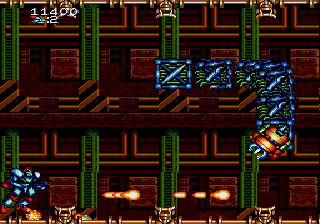 Heavy Unit is a port of the Japanese arcade game, and new levels were added for the home version. This is nice, and the gameplay, while reminiscent of Gradius with its simultaneous shot/bomb set up, is hampered a bit by a slow default speed and your foes’ blatant disregard for solid objects. Yes, while you can blow up instantly from scraping a wall (and you will), everything else can phase right through rock, stone, and metal! This takes some getting used to, to say the least, and can be problematic when more than one foe decides to pull this stunt at the same time. Once past this, however, Heavy Unit is a great shmup. I love the ability to transform into a robot (reminds me of Side Arms), and the graphics are great for such an early game. It even has a password feature! I suspect that Heavy Unit was left in Japan due to the glut of shmups that hit the Genesis between 1990 and 1991, and that’s too bad. It’s a solid game that’s actually better than some of the shmups that made it stateside during the time. Luckily, an import copy won’t run you too much.
Heavy Unit is a port of the Japanese arcade game, and new levels were added for the home version. This is nice, and the gameplay, while reminiscent of Gradius with its simultaneous shot/bomb set up, is hampered a bit by a slow default speed and your foes’ blatant disregard for solid objects. Yes, while you can blow up instantly from scraping a wall (and you will), everything else can phase right through rock, stone, and metal! This takes some getting used to, to say the least, and can be problematic when more than one foe decides to pull this stunt at the same time. Once past this, however, Heavy Unit is a great shmup. I love the ability to transform into a robot (reminds me of Side Arms), and the graphics are great for such an early game. It even has a password feature! I suspect that Heavy Unit was left in Japan due to the glut of shmups that hit the Genesis between 1990 and 1991, and that’s too bad. It’s a solid game that’s actually better than some of the shmups that made it stateside during the time. Luckily, an import copy won’t run you too much.
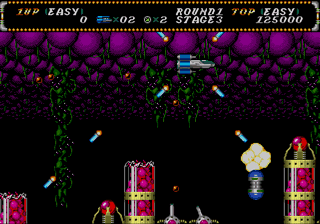 Even after all these years, I still find it humorously ironic just how well the title Hellfire fits this game. Harder than most shmups, Hellfire is a great game nonetheless, and though some argue that the PC-Engine version is superior, I prefer the Genesis port. Sure, the graphics aren’t as crisp or detailed as the arcade original and the music might not be as good as it is on PCE. What is the same is the insane difficulty level and the Gradius-style gameplay. As one of only four games released by publisher Seismic (they also gave us the godly M.U.S.H.A.) Hellfire is hard enough to make even the most confident of shmuppers cry like a little girl. What’s that? You lost your über powered up ship on level three? Better start over friend, because your little pea shooter is hardly a match for what’s in store. You could also break out that Game Genie, but that wouldn’t make you “hardcore,” now, would it? I, for one, prefer my wits and a healthy blood pressure level to being “hardcore” so my Game Genie is already waiting.
Even after all these years, I still find it humorously ironic just how well the title Hellfire fits this game. Harder than most shmups, Hellfire is a great game nonetheless, and though some argue that the PC-Engine version is superior, I prefer the Genesis port. Sure, the graphics aren’t as crisp or detailed as the arcade original and the music might not be as good as it is on PCE. What is the same is the insane difficulty level and the Gradius-style gameplay. As one of only four games released by publisher Seismic (they also gave us the godly M.U.S.H.A.) Hellfire is hard enough to make even the most confident of shmuppers cry like a little girl. What’s that? You lost your über powered up ship on level three? Better start over friend, because your little pea shooter is hardly a match for what’s in store. You could also break out that Game Genie, but that wouldn’t make you “hardcore,” now, would it? I, for one, prefer my wits and a healthy blood pressure level to being “hardcore” so my Game Genie is already waiting.
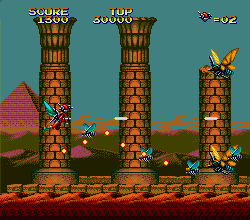 What happened here? After playing the great arcade version of this, I was expecting something more or less along the same lines, given the Genesis’ ability to produce accurate ports of arcade shmups at the time. This is simply not what I expected. Boring, slow-paced gameplay that goes NOWHERE, and some of the blandest graphics on the system. Where the hell did all the parallax go? There isn’t a single line here. Nothing. Zip. Zilch. Nada. Even worse, the character sprites are watered down from the original, and even your craft looks like crap. Shouldn’t a shmup about bugs have some big, ugly, mean-looking bugs? What we have here looks more like an episode of Miss Spider’s Sunny Patch Kids with guns. This is not the way to do an arcade shmup justice, and even Sage’s Creation should be above such a bad port. If you simply must have every shmup available for the Genesis, then by all means, pick up a copy. Everyone else should use their money for something decent.
What happened here? After playing the great arcade version of this, I was expecting something more or less along the same lines, given the Genesis’ ability to produce accurate ports of arcade shmups at the time. This is simply not what I expected. Boring, slow-paced gameplay that goes NOWHERE, and some of the blandest graphics on the system. Where the hell did all the parallax go? There isn’t a single line here. Nothing. Zip. Zilch. Nada. Even worse, the character sprites are watered down from the original, and even your craft looks like crap. Shouldn’t a shmup about bugs have some big, ugly, mean-looking bugs? What we have here looks more like an episode of Miss Spider’s Sunny Patch Kids with guns. This is not the way to do an arcade shmup justice, and even Sage’s Creation should be above such a bad port. If you simply must have every shmup available for the Genesis, then by all means, pick up a copy. Everyone else should use their money for something decent.
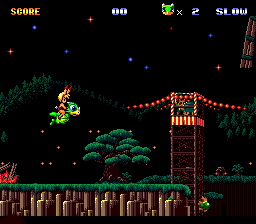 Anyone who can’t find something good in a game about a girl in a bunny suit who rides a dragon into battle needs to be medicated. Certainly not the deepest shmup ever made but by far one of the weirdest, Keio Flying Squadron tells the tale of Rami, a young girl who must retrieve the key to the powerful ark from the nefarious Dr. Pon. Hey, I said it was weird, didn’t I? That’s the whole charm of this game, essentially. The off-the-wall humor and wacky enemies are almost a parody of the genre. It never takes itself too seriously, even during boss battles (those with a raccoon phobia need not apply, as the little critters are everywhere!). It’s not exactly the most complex shooter out there. The weapon system is ho-hum, the music is decent (and red book!), and the graphics are good but nothing spectacular. Even so, you need this game in your collection. Where it really shines is in the cut scenes. Beat a stage and you’re rewarded with some cinema scenes that further the story along. I found myself playing just to see what would happen next. It’s truly amazing that JVC took a chance on this and localized it. I’m sure it probably tanked in sales. It has become something of a cult classic (complete copies are currently going for upwards of $75 on eBay), as more and more gamers discover this little gem for their Sega CD. HYPER CUTIE FIGHTING SHAPE!
Anyone who can’t find something good in a game about a girl in a bunny suit who rides a dragon into battle needs to be medicated. Certainly not the deepest shmup ever made but by far one of the weirdest, Keio Flying Squadron tells the tale of Rami, a young girl who must retrieve the key to the powerful ark from the nefarious Dr. Pon. Hey, I said it was weird, didn’t I? That’s the whole charm of this game, essentially. The off-the-wall humor and wacky enemies are almost a parody of the genre. It never takes itself too seriously, even during boss battles (those with a raccoon phobia need not apply, as the little critters are everywhere!). It’s not exactly the most complex shooter out there. The weapon system is ho-hum, the music is decent (and red book!), and the graphics are good but nothing spectacular. Even so, you need this game in your collection. Where it really shines is in the cut scenes. Beat a stage and you’re rewarded with some cinema scenes that further the story along. I found myself playing just to see what would happen next. It’s truly amazing that JVC took a chance on this and localized it. I’m sure it probably tanked in sales. It has become something of a cult classic (complete copies are currently going for upwards of $75 on eBay), as more and more gamers discover this little gem for their Sega CD. HYPER CUTIE FIGHTING SHAPE!
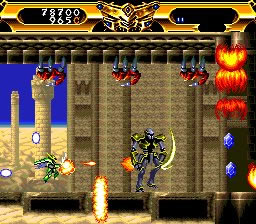 Not as pretty as the Turbo Duo version and suffering from a smaller color palette, the Sega CD release of Lords of Thunder also has a remixed soundtrack. Why this was done is beyond me, and it makes little sense. The original soundtrack was perfect. Questionable changes notwithstanding, it’s still a great game that all Sega CD owners need to play. There are plenty of stages, power ups galore, and a decent challenge level. The intro now has voice narration, and the ending is excellent. The boss battles have ramped up and these master baddies now take more hits than ever to dispatch. I find myself going back to this one a few times a year, as the remixed soundtrack still rocks, just not as hard as its Duo cousin. The gameplay is tight and the shop concept (think Forgotten Worlds) is something I would like to see more games in the genre embrace. Collecting money from fallen foes to buy new weapons makes more sense than these suicide power up capsules that just run out into a firefight to die.
Not as pretty as the Turbo Duo version and suffering from a smaller color palette, the Sega CD release of Lords of Thunder also has a remixed soundtrack. Why this was done is beyond me, and it makes little sense. The original soundtrack was perfect. Questionable changes notwithstanding, it’s still a great game that all Sega CD owners need to play. There are plenty of stages, power ups galore, and a decent challenge level. The intro now has voice narration, and the ending is excellent. The boss battles have ramped up and these master baddies now take more hits than ever to dispatch. I find myself going back to this one a few times a year, as the remixed soundtrack still rocks, just not as hard as its Duo cousin. The gameplay is tight and the shop concept (think Forgotten Worlds) is something I would like to see more games in the genre embrace. Collecting money from fallen foes to buy new weapons makes more sense than these suicide power up capsules that just run out into a firefight to die.
It may not be the best version of the game out there but it’s undoubtedly the cheapest and easiest to come by. Check out our Side-by-Side feature comparing it to the Super CD-ROM version.
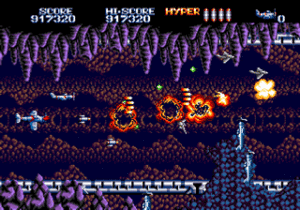 Originally developed by NMK and released by Jaleco in May 1988, P-47: The Phantom Fighter is a retro World War II arcade shooter that was ported from one system to another, although a suggested Mega Drive version never materialized—until this day. This first official release on Genesis/Mega Drive platforms gave players the chance to control the U.S. Army Air Forces’ P-47 Thunderbolt on European and Pacific battlefronts, and featured multilayered scrolling and richly detailed stage environments. The physical release came packaged with a 16-bit cartridge, 8mm CD soundtrack, full-color manual, reversible sleeve, and numbered commemorative slipcase with art by legendary illustrator Tankro Kato.
Originally developed by NMK and released by Jaleco in May 1988, P-47: The Phantom Fighter is a retro World War II arcade shooter that was ported from one system to another, although a suggested Mega Drive version never materialized—until this day. This first official release on Genesis/Mega Drive platforms gave players the chance to control the U.S. Army Air Forces’ P-47 Thunderbolt on European and Pacific battlefronts, and featured multilayered scrolling and richly detailed stage environments. The physical release came packaged with a 16-bit cartridge, 8mm CD soundtrack, full-color manual, reversible sleeve, and numbered commemorative slipcase with art by legendary illustrator Tankro Kato.
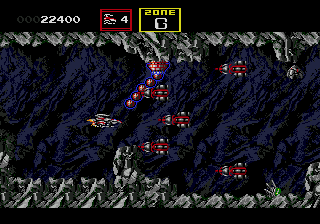 The only Darius game to appear on the Genesis, Sagaia (Darius 2 in Japan) may have been affected by the name change. I’m sure that more gamers would have taken notice of it had it arrived bearing its famous moniker. Even with the new title, it still has all the great elements that make the Darius series such a fan favorite. Shooting at flying fish is strangely fun, which sounds odder than it actually is. Darius Twin on the SNES may be more colorful (as are a lot of SNES ports), and Darius 2 on the PC-Engine CD may have a better soundtrack, but Taito’s port holds its own on the Genesis. Being able to play with a friend at the same time adds a great deal to the gameplay, though some flicker can get in the way sometimes. No Genesis shmup fan should be without Sagaia, if at least to represent the series, which is something this game does very well.
The only Darius game to appear on the Genesis, Sagaia (Darius 2 in Japan) may have been affected by the name change. I’m sure that more gamers would have taken notice of it had it arrived bearing its famous moniker. Even with the new title, it still has all the great elements that make the Darius series such a fan favorite. Shooting at flying fish is strangely fun, which sounds odder than it actually is. Darius Twin on the SNES may be more colorful (as are a lot of SNES ports), and Darius 2 on the PC-Engine CD may have a better soundtrack, but Taito’s port holds its own on the Genesis. Being able to play with a friend at the same time adds a great deal to the gameplay, though some flicker can get in the way sometimes. No Genesis shmup fan should be without Sagaia, if at least to represent the series, which is something this game does very well.
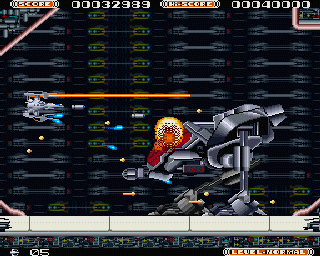 I think it’s safe to include both the Genesis and Sega CD versions of this game here. Be it Sol-Feace or Sol-Deace, both are pretty run-of-the-mill. I get the impression that Wolf Team was striving for a Gate of Thunder feel here, and they kind of came up short. I’m not saying that either Sol is bad (I prefer the Sega CD version myself for its cut scenes and music), but the TG-CDROM’s killer app just trounces them. The biggest problem here is that everything is so slow. While shmups shouldn’t zip along at the speed of light, they shouldn’t be driving Miss Daisy either. You basically plod along through each stage, until you finally come to a boss, which is usually unspectacular too. There’s also some nasty flicker that can occasionally get in the way of oncoming bullets, which is never a good thing. Aside from these two problems, the game isn’t bad at all. As I mentioned above, the Sega CD version is the way to go, with its story enhancements and great music. I especially liked the patented Wolf Team maraca sound (wouldn’t be a WF game without it!) and the cool multi-jointed foes.
I think it’s safe to include both the Genesis and Sega CD versions of this game here. Be it Sol-Feace or Sol-Deace, both are pretty run-of-the-mill. I get the impression that Wolf Team was striving for a Gate of Thunder feel here, and they kind of came up short. I’m not saying that either Sol is bad (I prefer the Sega CD version myself for its cut scenes and music), but the TG-CDROM’s killer app just trounces them. The biggest problem here is that everything is so slow. While shmups shouldn’t zip along at the speed of light, they shouldn’t be driving Miss Daisy either. You basically plod along through each stage, until you finally come to a boss, which is usually unspectacular too. There’s also some nasty flicker that can occasionally get in the way of oncoming bullets, which is never a good thing. Aside from these two problems, the game isn’t bad at all. As I mentioned above, the Sega CD version is the way to go, with its story enhancements and great music. I especially liked the patented Wolf Team maraca sound (wouldn’t be a WF game without it!) and the cool multi-jointed foes.
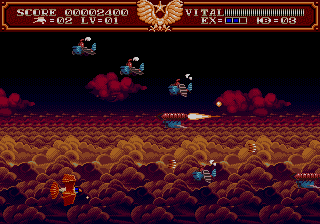 Steel Empire is a bit of an odd title. It almost has a Sky Captain & the World of Tomorrow feel to it with all the steam airships and planes. The only thing about it is that the original designs don’t really add too much to the gameplay, which is pretty standard fair. Everything is well detailed, sure (the game could use a bit more color though), but that’s about as far as it goes. Don’t expect anything innovative and you should be fine. I’m not knocking the game overall, I just feel that had the gameplay been as inspired as the design work, this could have been a much stronger title. The fact that you can blow through it quickly doesn’t help much either. I really did love the whole atmosphere of the game and do take it out for a spin every so often, as it’s worth having if you can find it cheap. Great for an afternoon but you probably won’t need more than that to see everything.
Steel Empire is a bit of an odd title. It almost has a Sky Captain & the World of Tomorrow feel to it with all the steam airships and planes. The only thing about it is that the original designs don’t really add too much to the gameplay, which is pretty standard fair. Everything is well detailed, sure (the game could use a bit more color though), but that’s about as far as it goes. Don’t expect anything innovative and you should be fine. I’m not knocking the game overall, I just feel that had the gameplay been as inspired as the design work, this could have been a much stronger title. The fact that you can blow through it quickly doesn’t help much either. I really did love the whole atmosphere of the game and do take it out for a spin every so often, as it’s worth having if you can find it cheap. Great for an afternoon but you probably won’t need more than that to see everything.
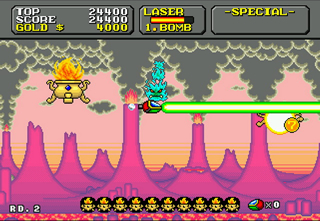 Sega Master System fans know this series well. The adventures of Opa-Opa are legendary on that console (spanning three adventures in total) and although he made the trip to 16-bit, Sega of America was blind enough to not bring it to the U.S. The game was released in Japan and Europe and a PAL copy can be had for cheap on eBay (it’s in English to boot!).
Sega Master System fans know this series well. The adventures of Opa-Opa are legendary on that console (spanning three adventures in total) and although he made the trip to 16-bit, Sega of America was blind enough to not bring it to the U.S. The game was released in Japan and Europe and a PAL copy can be had for cheap on eBay (it’s in English to boot!).
The game plays identically to earlier installments, and this is essentially more of the same. When “the same” constitutes great gameplay and crisp, colorful graphics, there’s no need to change anything. Super Fantasy Zone also sports a neat intro and ending, and this only rounds out an excellent package for those who love blowing things up for coins. All your favorite weapons and items are here and you’ll make good use of them against the huge bosses that are much more dangerous than they look.
The  Series
Series
Any fan of the genre knows the Thunder Force games. Loved for its blistering action, awesome bosses, and hardware-pushing graphics, the series is considered by many as the definitive shmup franchise on the Genesis. Thunder Force 2 was originally released alongside the system around launch and while it was a decent game in its own right, it didn’t click with gamers right away. Truxton, the other shmup available (vertical and very good!) attracted more fans with its great gameplay and HUGE bomb detonations. It wasn’t until the third entry in the Force series came out in 1990 that people stood up and took notice. Part three did away with the overhead levels from the previous game and concentrated on making the horizontal levels about as good as coding would allow, even going so far as to let you choose the order of the first four levels (something emulated in many later shmups). Nothing like it had been released and it was the shmup to own that year. It was eventually whored out for a flat, dull port on the SNES called Thunder Spirits.
 Another sequel followed, called Lightening Force (not only did Sega mess with the name, they couldn’t even spell it correctly) and continued the tradition of huge bosses and mind-blowing graphics and was much harder than either of the previous games. It added levels that now scrolled up or down several screens, which made finding that certain power up a major pain.
Another sequel followed, called Lightening Force (not only did Sega mess with the name, they couldn’t even spell it correctly) and continued the tradition of huge bosses and mind-blowing graphics and was much harder than either of the previous games. It added levels that now scrolled up or down several screens, which made finding that certain power up a major pain.
The series would get only one more installment, this time on the Saturn, and then lamentably fade into obscurity. Read more about the franchise in the Thunder Force edition of our Forgotten Franchise article series.
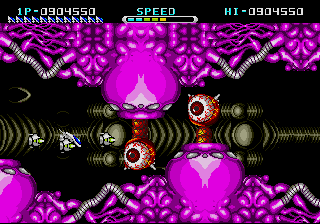 Another one of Renovation’s lineup of shmups for the Genesis, Whip Rush is quite a decent title, especially for an R-Type clone. The graphics are clean, and the sprites are large and well detailed. There’s plenty of parallax and the backgrounds are colorful. The game has all the bells and whistles of a typical shmup from the era and the weapon’s system is nothing to brag about. It’s one of those games that you know is just a blatant copy of another (and much better title) but you decide to play it anyway and just enjoy it for what it is. The gameplay is solid enough, with some good boss battles sprinkled about. Most diehard shmup fans won’t find anything to scream about but those new to the genre will be able to dive right in. Considering that this was one of the first shmups to be released for the Genesis (it retailed for about $70!), I kind of forgive Whip Rush for not having aged as gracefully as other titles have. I would still recommend you pick it up and give it a try though.
Another one of Renovation’s lineup of shmups for the Genesis, Whip Rush is quite a decent title, especially for an R-Type clone. The graphics are clean, and the sprites are large and well detailed. There’s plenty of parallax and the backgrounds are colorful. The game has all the bells and whistles of a typical shmup from the era and the weapon’s system is nothing to brag about. It’s one of those games that you know is just a blatant copy of another (and much better title) but you decide to play it anyway and just enjoy it for what it is. The gameplay is solid enough, with some good boss battles sprinkled about. Most diehard shmup fans won’t find anything to scream about but those new to the genre will be able to dive right in. Considering that this was one of the first shmups to be released for the Genesis (it retailed for about $70!), I kind of forgive Whip Rush for not having aged as gracefully as other titles have. I would still recommend you pick it up and give it a try though.
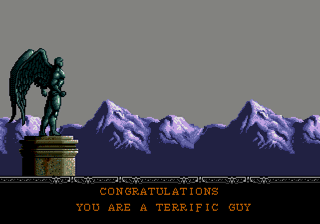 Dreamworks (not the Spielberg one) released a few gems on the Genesis (Target Earth comes to mind) and among them was Wings of Wor. It kind of reminds me of a horizontal Legendary Wings, what with the style of play and all. The main sprite is a bit too small sometimes and there’s often the problem of bullets getting mixed with the backgrounds but more often than not, the game is a blast to play and keeps you on your toes all the way from beginning to end. Massive weapon upgrades give you the necessary firepower to ward off everything but the kitchen sink and you’ll need them. Parallax abounds and there are some neat background effects for such an early title (the earthquake in stage one and stage four’s “lung” background, for example). The music gets the job done and not much else but where this title excels is in the gameplay. Prepare to suffer! Not enough people gave Wings of Wor a chance and they’re doing themselves a disservice by not playing it.
Dreamworks (not the Spielberg one) released a few gems on the Genesis (Target Earth comes to mind) and among them was Wings of Wor. It kind of reminds me of a horizontal Legendary Wings, what with the style of play and all. The main sprite is a bit too small sometimes and there’s often the problem of bullets getting mixed with the backgrounds but more often than not, the game is a blast to play and keeps you on your toes all the way from beginning to end. Massive weapon upgrades give you the necessary firepower to ward off everything but the kitchen sink and you’ll need them. Parallax abounds and there are some neat background effects for such an early title (the earthquake in stage one and stage four’s “lung” background, for example). The music gets the job done and not much else but where this title excels is in the gameplay. Prepare to suffer! Not enough people gave Wings of Wor a chance and they’re doing themselves a disservice by not playing it.
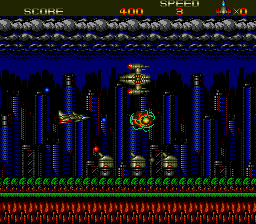 I’ve never heard of Unipacc, the company responsible for XDR. The graphical style reminds of those games done by Sage’s Creation, where all the backgrounds looked like they were first done on the NES, and merely had their color count upped for release on the Genesis. That pretty much sums up XDR, as there’s nothing out of the ordinary or eye catching here. It’s a standard horizontal shmup with a generic weapons system and cliched bosses. The game doesn’t even have an opening sequence (or story at all, for that matter). Sound and music are dull, and even the enemies tend to come at you without any motivation. I bet if you could scream at them to go away, they probably would (wouldn’t that make for an interesting power up?). I know it was released in 1990, but there were many other shmups from that year that tried. XDR doesn’t even try in the slightest to be anything more than a run-of-the-mill outing that puts out just the minimum amount of effort. I was taught to never strive for just the minimum, and that’s why I think I’ll pass on this one.
I’ve never heard of Unipacc, the company responsible for XDR. The graphical style reminds of those games done by Sage’s Creation, where all the backgrounds looked like they were first done on the NES, and merely had their color count upped for release on the Genesis. That pretty much sums up XDR, as there’s nothing out of the ordinary or eye catching here. It’s a standard horizontal shmup with a generic weapons system and cliched bosses. The game doesn’t even have an opening sequence (or story at all, for that matter). Sound and music are dull, and even the enemies tend to come at you without any motivation. I bet if you could scream at them to go away, they probably would (wouldn’t that make for an interesting power up?). I know it was released in 1990, but there were many other shmups from that year that tried. XDR doesn’t even try in the slightest to be anything more than a run-of-the-mill outing that puts out just the minimum amount of effort. I was taught to never strive for just the minimum, and that’s why I think I’ll pass on this one.
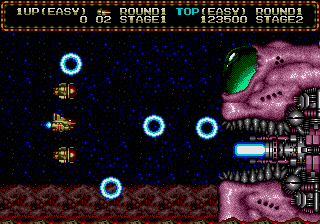 Probably the most famous shmup on the Genesis, it’s ironic that Zero Wing’s fame has little to do with the game itself and comes mostly from the “all your base” comment in the opening cut scene. Once you actually play the game, you find that it’s a tight little shmup that while not on the same level as Thunder Force III or even Wings of Wor, is still pretty good. A decent weapons system goes far towards making up for the middle-of-the-road visuals and the amount of stages is just right. Overall, Zero Wing is another example of a slightly above average shmup that’s worth the $10 or so it should cost you. Just make sure to get the European version, as that cut scene alone is worth the price of admission.
Probably the most famous shmup on the Genesis, it’s ironic that Zero Wing’s fame has little to do with the game itself and comes mostly from the “all your base” comment in the opening cut scene. Once you actually play the game, you find that it’s a tight little shmup that while not on the same level as Thunder Force III or even Wings of Wor, is still pretty good. A decent weapons system goes far towards making up for the middle-of-the-road visuals and the amount of stages is just right. Overall, Zero Wing is another example of a slightly above average shmup that’s worth the $10 or so it should cost you. Just make sure to get the European version, as that cut scene alone is worth the price of admission.
I still wonder to this day why it was never brought over to the states and PAL games that are left in Europe infuriate me. If everything is already translated, bring it over!
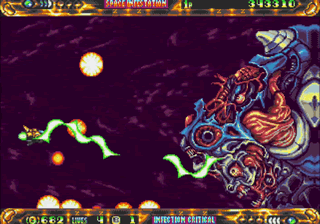 After a very successful Kickstarter campaign, ZPF Team and Mega Cat Studios have finally brought us a shmup with three playable characters, tons of different stages, and lots of big bosses. Along with its fast-pace and visually intense gameplay experience, ZPF leans a bit in a different direction with an added level of strategy with coins left behind by enemies to be used to purchase weapon upgrades, à la Forgotten Worlds, and includes hidden treasures and unlockables for more advanced players.
After a very successful Kickstarter campaign, ZPF Team and Mega Cat Studios have finally brought us a shmup with three playable characters, tons of different stages, and lots of big bosses. Along with its fast-pace and visually intense gameplay experience, ZPF leans a bit in a different direction with an added level of strategy with coins left behind by enemies to be used to purchase weapon upgrades, à la Forgotten Worlds, and includes hidden treasures and unlockables for more advanced players.
Click to the next page to see all the vertical shmups on the Genesis, Sega CD, and 32X!

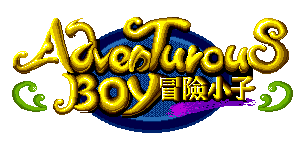

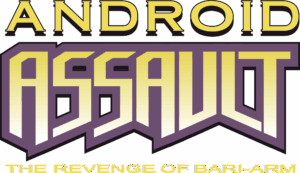
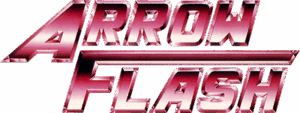

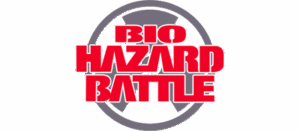
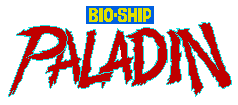
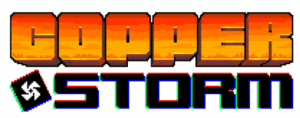
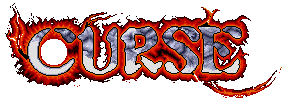
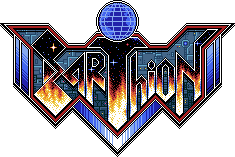
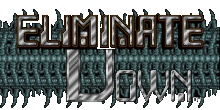
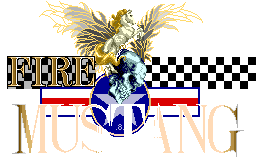
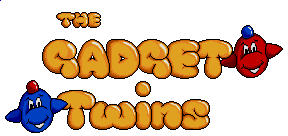


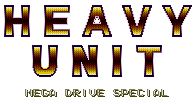
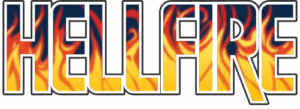


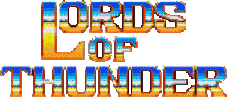


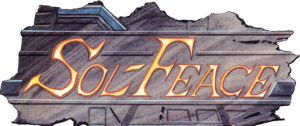
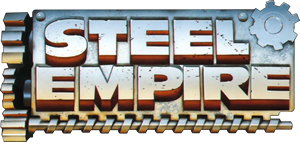
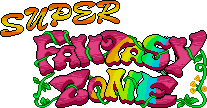

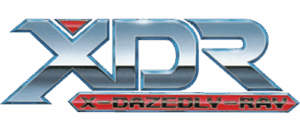
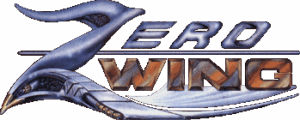
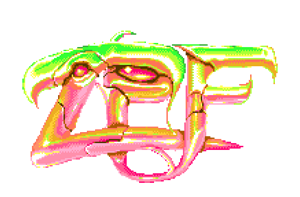
Recent Comments